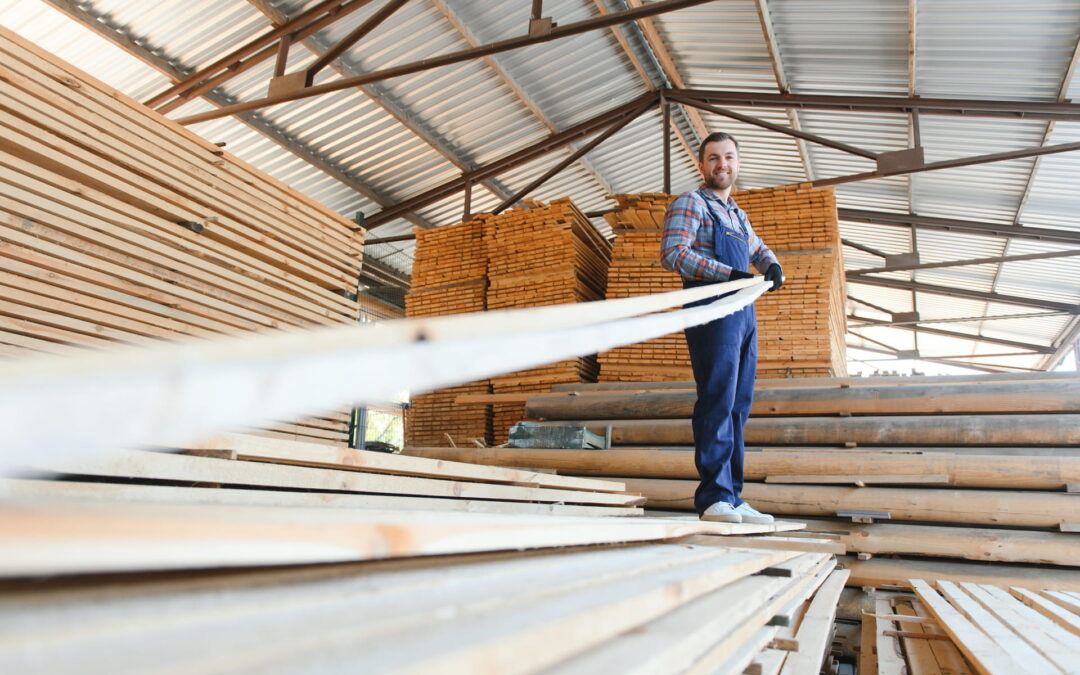Lumber warping can happen to anyone if the wood isn’t stored correctly. When lumber absorbs moisture from the air or dries out too quickly, it can lead to the wood bending or twisting. This warping compromises the structural integrity of the wood, making it less suitable for projects that require precise measurements or straight edges. Warping can also affect the aesthetic of the wood, ruining the overall look of a finished project.
A builder might find that lumber bought for a deck warps in the weeks before construction starts, making some pieces unusable. Preventing warping requires understanding the underlying causes, especially when working in climates with high humidity or fluctuating temperatures.
- Wood absorbs moisture, causing swelling or shrinking.
- Rapid drying can cause uneven changes in the wood, leading to twisting or bending.
- Inconsistent storage conditions create environments where different sections of the wood dry unevenly.
Optimal conditions for storing lumber
Keeping lumber in the right conditions is the first step to preventing warping. Lumber should always be stored in a dry, well-ventilated area where it’s protected from the elements. Consistent airflow and temperature are crucial in maintaining the moisture content of the wood. Lumber storage becomes especially tricky in humid regions where improper storage can accelerate warping.
Anyone who has worked on large construction projects knows that stacking wood in poorly ventilated spaces or outdoors without protection often leads to unwanted warping. For example, storing wood in a damp shed can cause certain boards to swell while others dry out, resulting in uneven boards that no longer fit together.
- Store lumber in a dry, shaded area, away from moisture and direct sunlight.
- Use spacers between boards to allow air to circulate.
- Avoid placing lumber directly on the ground, as it can absorb moisture from the soil.
How to stack lumber to prevent warping
Stacking lumber the right way plays a key role in keeping it straight. When boards are laid flat and evenly spaced, they have less opportunity to warp over time. Stacking should always involve horizontal layers with small gaps between boards to promote even air circulation. Whether the lumber is indoors or outdoors, it should be well-supported and stacked at an angle that prevents sagging.
A carpenter who frequently stores lumber might share the importance of using spacers to ensure each board dries evenly. Stacking the wood tightly against each other without spacers can trap moisture, especially if the wood hasn’t been properly dried by the supplier.
- Stack lumber horizontally with spacers between each board.
- Use strong supports at regular intervals to prevent sagging.
- Keep stacks no more than 4 feet tall to avoid unnecessary pressure on lower boards.
Indoor vs outdoor lumber storage in New Orleans
The decision between storing lumber indoors or outdoors depends on several factors, including the available space and the local climate. Indoor storage offers better protection from the elements, but it’s not always an option, especially for large quantities of lumber. Outdoor storage is possible in the New Orleans area if the wood is properly protected, but additional precautions are necessary to prevent moisture buildup.
Experienced builders might explain how indoor storage ensures better protection against rapid temperature changes and excess humidity, which are common causes of warping. On the other hand, outdoor storage requires special covering and constant monitoring to prevent moisture damage.
- Indoor storage provides the best protection against humidity and temperature changes.
- Outdoor storage requires waterproof coverings but should still allow air circulation.
- Lumber stored outdoors should be checked regularly for signs of moisture buildup.
Best practices for covering lumber outdoors
When storing lumber outdoors, covering it is essential to protect it from rain and direct sunlight, both of which can contribute to warping. However, improper covering can actually trap moisture, leading to a greater risk of damage. Using a tarp or plastic covering can shield the wood from the elements, but it’s important to leave space for air to circulate underneath the covering.
A contractor might recall a time when lumber was improperly covered with a tarp that pressed directly against the boards. Without airflow, condensation built up under the covering, causing moisture to seep into the wood.
- Use a breathable, waterproof covering like a tarp to protect lumber from rain.
- Ensure that the covering is elevated above the wood to allow for air circulation.
- Avoid completely sealing the wood under plastic, as this can trap moisture.
Storing pressure-treated lumber from a lumber yard in New Orleans
Pressure-treated lumber requires special care when it comes to storage. This type of lumber is designed to resist decay, insects, and moisture, making it ideal for outdoor projects. However, improper storage can still lead to warping. Even though pressure-treated lumber has been chemically treated to withstand the elements, it can still absorb excess moisture if not properly stored.
For builders working with pressure-treated wood, ensuring that it stays off the ground and is properly covered can be the difference between success and failure. Despite its treatment, pressure-treated lumber is still vulnerable to moisture if not given room to breathe.
- Pressure-treated lumber should be stored off the ground to prevent moisture absorption.
- Proper covering is necessary to shield the wood from rain and direct sunlight.
- Always allow air to circulate around pressure-treated wood to prevent warping.
Common mistakes to avoid when storing lumber
There are a few common mistakes that can lead to warped or damaged lumber. Many people make the error of stacking wood directly on the ground, which exposes it to soil moisture. Another mistake is failing to provide adequate support underneath the lumber, which can lead to sagging over time. Finally, improper covering, such as wrapping lumber too tightly in plastic, can cause condensation to form, leading to moisture damage.
An experienced woodworker might recall a project where improperly stored lumber had to be replaced due to warping. Avoiding these common mistakes can help ensure that the lumber you purchase stays in excellent condition for your project.
- Never store lumber directly on the ground, as it absorbs moisture from the soil.
- Always provide even support for the entire stack to prevent sagging.
- Avoid covering lumber too tightly; leave room for air circulation to prevent condensation.
Maintaining lumber quality for long-term projects
For those who plan to store lumber for extended periods before starting a project, it’s important to take extra precautions to maintain quality. Lumber that sits for long stretches without proper care can warp, split, or degrade over time. Ensuring that the storage environment remains stable and that the wood is regularly checked will help prevent surprises down the road.
A contractor in the New Orleans area who routinely stores lumber long-term might emphasize the importance of checking for moisture buildup and rotating the wood to ensure even drying.
- Inspect stored lumber regularly for signs of moisture damage or warping.
- Rotate stacks of lumber periodically to ensure even drying.
- Keep the storage area clean and free of debris that could introduce moisture or pests.
Key takeaways for storing lumber properly
- Proper stacking with spacers and support is essential to prevent warping.
- Indoor storage offers better protection, but outdoor storage can work with the right precautions.
- Pressure-treated lumber needs airflow and elevation off the ground for optimal storage.
Frequently Asked Questions
1. How long can lumber be stored in New Orleans without warping?
Lumber can be stored for months or even years if it’s properly stacked, covered, and kept in a stable environment with consistent airflow and low humidity.
2. Can warped lumber be fixed?
In some cases, warped lumber can be fixed by applying heat and moisture and then clamping the wood to straighten it. However, severely warped boards may need to be replaced.
3. Should I cover my lumber with plastic?
Plastic can be used to cover lumber, but it’s important to ensure the wood has space for air circulation. Sealing lumber too tightly can trap moisture, leading to warping.
4. How do I prevent lumber from absorbing moisture?
Store lumber off the ground, cover it with a breathable tarp, and ensure proper air circulation to prevent moisture absorption.
5. Can lumber be stored outdoors year-round?
Yes, lumber can be stored outdoors, but it must be covered and kept off the ground to avoid moisture exposure. Check the wood regularly for any signs of warping or damage.

